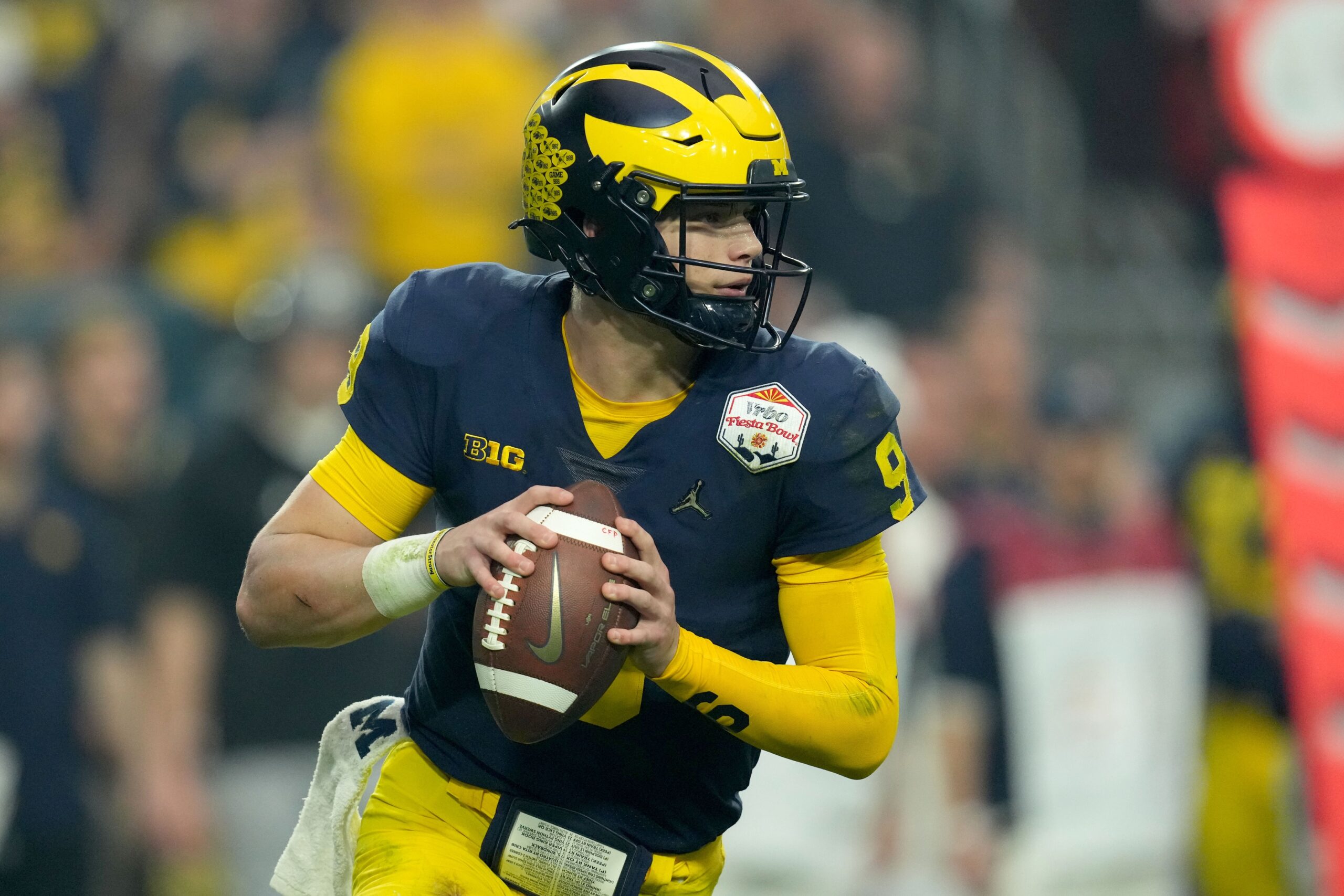JJ McCarthy’s Injury and Recovery

JJ McCarthy, the talented quarterback for the University of Michigan Wolverines, faced a significant setback in his football career when he sustained a knee injury during the 2023 season. The injury, which required surgery, raised concerns about his recovery and potential impact on his future performance.
The Nature of the Injury
JJ McCarthy’s knee injury involved a tear of the anterior cruciate ligament (ACL), a major ligament that helps stabilize the knee joint. This injury is common in athletes, particularly those involved in high-impact sports like football. The ACL tear occurred during a game against the Penn State Nittany Lions on October 21, 2023, forcing McCarthy to miss the remainder of the season.
The Surgical Procedure
Following the diagnosis, JJ McCarthy underwent a surgical procedure to repair the torn ACL. The surgery involved reconstructing the ligament using a graft, which is typically taken from another part of the body, such as the hamstring or patellar tendon. The procedure aims to restore the stability of the knee joint and allow for proper function.
Rehabilitation Process
After surgery, JJ McCarthy embarked on a rigorous rehabilitation process to regain strength, flexibility, and stability in his knee. The rehabilitation program typically involves a combination of physical therapy, exercises, and other treatments.
- Physical Therapy: Physical therapists work closely with patients to guide them through a series of exercises designed to strengthen the muscles surrounding the knee, improve range of motion, and restore proper biomechanics.
- Exercises: Rehabilitation exercises include a variety of activities, such as squats, lunges, hamstring curls, and calf raises. These exercises gradually increase in intensity and complexity as the knee heals.
- Other Treatments: Rehabilitation may also involve other treatments, such as cryotherapy (cold therapy), electrical stimulation, and massage therapy, to reduce pain, inflammation, and promote healing.
Impact on Athletic Performance
The impact of an ACL tear and subsequent surgery on an athlete’s performance can vary depending on several factors, including the severity of the injury, the individual’s age, fitness level, and adherence to the rehabilitation program.
- Potential Challenges: Athletes who have undergone ACL reconstruction may face challenges such as decreased explosiveness, reduced agility, and increased risk of reinjury.
- Successful Recoveries: However, with proper rehabilitation and dedicated effort, many athletes can return to their previous level of performance. The recovery process can take several months, and athletes often need to make adjustments to their training and playing style to minimize the risk of future injuries.
Impact on Michigan Football: Jj Mccarthy Knee Surgery

JJ McCarthy’s knee injury undoubtedly cast a shadow over the Michigan Wolverines’ football season, leaving fans and analysts alike wondering about the team’s ability to navigate the remainder of the campaign without their starting quarterback. The absence of McCarthy, a pivotal player in Michigan’s offensive strategy, forced the team to adapt and rely on the depth and resilience within their ranks.
Offensive Strategy Adjustments
The absence of JJ McCarthy demanded a significant shift in Michigan’s offensive approach. The team had to adapt their game plan to accommodate the strengths of their backup quarterback, Cade McNamara. This adjustment involved a more conservative approach, focusing on a balanced run-pass game and minimizing risky plays. While the Wolverines’ offense was not as explosive as it had been with McCarthy at the helm, the team’s commitment to a disciplined and efficient strategy proved effective in several key matchups.
Perspective on Knee Injuries in Athletes
/cdn.vox-cdn.com/uploads/chorus_image/image/71873851/1245372218.0.jpg)
Knee injuries are a common occurrence in athletes, particularly those participating in high-impact sports. These injuries can range from minor sprains to severe ligament tears, significantly impacting an athlete’s performance and career. Understanding the causes, symptoms, and treatment options for these injuries is crucial for athletes and their medical teams to ensure proper management and optimize recovery.
Common Knee Injuries in Athletes
Knee injuries are prevalent in athletes, often resulting from repetitive stress, sudden impact, or improper biomechanics. Common types of knee injuries include:
- Anterior Cruciate Ligament (ACL) Tear: This injury involves a tear in the ACL, a strong ligament that connects the thighbone to the shinbone. It is commonly caused by sudden pivoting or twisting motions, often occurring during activities like basketball, soccer, and skiing.
- Posterior Cruciate Ligament (PCL) Tear: The PCL is another important ligament in the knee, responsible for preventing backward displacement of the shinbone. PCL tears are less common than ACL tears and often occur due to direct impact to the front of the knee.
- Medial Collateral Ligament (MCL) Tear: The MCL runs along the inside of the knee, providing stability. MCL tears are often caused by direct blows to the outside of the knee.
- Lateral Collateral Ligament (LCL) Tear: The LCL is located on the outside of the knee and helps stabilize the joint. LCL tears are less common than MCL tears and usually result from direct impact to the inside of the knee.
- Meniscus Tear: The meniscus is a C-shaped piece of cartilage that acts as a shock absorber in the knee. Meniscus tears can occur due to twisting or sudden impact, causing pain, swelling, and difficulty with movement.
- Patellar Tendinitis: This condition involves inflammation of the patellar tendon, which connects the kneecap to the shinbone. It is often caused by overuse or repetitive jumping motions.
Symptoms of Knee Injuries
The symptoms of knee injuries vary depending on the severity of the injury. Some common symptoms include:
- Pain: This is usually the most prominent symptom and can range from mild to severe.
- Swelling: Inflammation in the knee joint can cause significant swelling.
- Stiffness: Difficulty moving the knee or a feeling of tightness in the joint is common.
- Instability: A feeling of “giving way” or “buckling” in the knee can occur, particularly with ACL tears.
- Locking: The knee may get stuck in a bent position, often associated with meniscus tears.
- Popping or Clicking: A distinct popping or clicking sound may be heard at the time of injury, often indicating a ligament or meniscus tear.
Treatment Options for Knee Injuries
The treatment for knee injuries depends on the severity and type of injury. Common treatment options include:
- RICE (Rest, Ice, Compression, Elevation): This is the initial treatment for most knee injuries, helping to reduce pain, swelling, and inflammation.
- Medications: Over-the-counter pain relievers like ibuprofen or naproxen can help manage pain and inflammation. In some cases, stronger pain medications may be prescribed.
- Physical Therapy: Physical therapy plays a crucial role in rehabilitation after knee injuries. It involves exercises to improve range of motion, strength, and flexibility, helping to restore function and prevent re-injury.
- Surgery: Surgery is often recommended for severe injuries, such as complete ligament tears or complex meniscus tears. Surgical procedures aim to repair or reconstruct damaged structures.
Long-Term Implications of Knee Injuries, Jj mccarthy knee surgery
Knee injuries can have significant long-term implications for athletes, affecting their performance and career trajectory. These implications include:
- Reduced Athletic Performance: Knee injuries can lead to decreased strength, agility, and overall athletic performance, impacting an athlete’s ability to compete at their highest level.
- Increased Risk of Re-Injury: Athletes who have experienced a knee injury are at a higher risk of re-injury, especially if rehabilitation is not thorough or if proper preventative measures are not taken.
- Chronic Pain and Stiffness: Some knee injuries can lead to chronic pain and stiffness, even after treatment. This can significantly impact an athlete’s quality of life and ability to participate in physical activities.
- Early Retirement: Severe knee injuries can force athletes to retire prematurely, especially if they are unable to fully recover or if the risk of re-injury is too high.
Rehabilitation and Preventative Measures
Rehabilitation is crucial for athletes recovering from knee injuries. A comprehensive rehabilitation program should include:
- Early Mobilization: Initiating movement as soon as possible, within pain limits, helps to prevent stiffness and promote healing.
- Strength Training: Building muscle strength around the knee joint is essential for stability and support, reducing the risk of re-injury.
- Proprioceptive Exercises: These exercises help improve balance, coordination, and body awareness, which are crucial for preventing knee injuries.
- Functional Exercises: Gradually returning to sport-specific activities, starting with low-impact exercises and progressively increasing intensity.
Preventative measures can also play a significant role in reducing the risk of knee injuries. These measures include:
- Proper Warm-Up and Cool-Down: Adequate warm-up before exercise and cool-down after activity helps prepare the muscles and joints for exertion and prevent injuries.
- Strength Training: Regular strength training, focusing on the muscles around the knee, helps improve stability and reduce the risk of injuries.
- Proper Technique: Learning and maintaining proper technique during training and competition is crucial for reducing stress on the knee joint.
- Appropriate Footwear: Wearing supportive footwear that fits properly is essential for protecting the feet and ankles, which can indirectly affect knee health.
Jj mccarthy knee surgery – So, JJ McCarthy’s knee surgery is a big deal, right? It’s like, “Dude, you’re the quarterback! Get better!” But you know what’s even more nerve-wracking? Looking at the Vikings depth chart and realizing that if JJ’s out for a while, we might have to rely on someone who’s been warming the bench more than a hot dog vendor at a football game! Let’s hope JJ gets back in the game soon, or we might be in for a rough ride.
So, JJ McCarthy’s knee surgery, right? That’s a tough one. I mean, the guy’s a beast on the field, but a knee injury can really throw a wrench in things. To get a better idea of his athletic journey and the impact of the surgery, you should check out this article about jj mccarthy surgery.
Hopefully, he’ll be back to his old self soon, because we all know he’s got a bright future ahead of him. But until then, maybe we should get him a knee brace with a little motivational message like “Get Well Soon, You Knee-Genius!”
